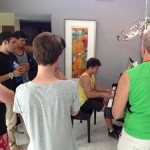I’m sometimes asked what we do at the Idyllwild Area Historical Society, so let me share an example.
One of the minor charms of living on our Hill is celebrity sightings. While we typically associate celebrity with entertainments like movies, television, or sports, it sometimes extends to the superwealthy. Think Warren Buffett, Bill Gates … or Chauncey and Marie Rankin Clarke.
In the 1920s, the Clarkes were one of Southern California’s wealthiest couples. Having first struck it rich in Arizona gold mining (not to mention his inheritance of a family distillery), they moved to the Los Angeles area in 1904 and began buying agricultural land.
In 1919, they built an 8,000-square-foot country house in an orange grove at Santa Fe Springs. Two years later, they found themselves atop one of the richest petroleum pools in history.
The noise and smell of oil production drove them to seek a more livable locale. So in 1922 the Clarkes began buying up desert land at what is now La Quinta. They established a large ranch, “Point Happy Date Gardens,” where Chauncey introduced the famous Deglet Noor variety of date palm and raised Arabian horses.
Following his death in 1926, Marie lived on at Point Happy until 1948. A leading philanthropist, her wealth produced the land for the Hollywood Bowl and a substantial bequest to Claremont Graduate University.
My interest in the Clarkes originated last fall when Louise Neeley of the Coachella Valley Historical Museum visited our local museum. She grew up at Point Happy because her mother had worked there, and she brought us a videotape of home movies from 1932-33 labeled “Point Happy and Idyllwild.”
Although its fuzzy footage reveals little more than a house on a steep, snow-covered hillside, the accompanying narration identifies it as the Clarkes’ Idyllwild cabin. Ms. Neeley’s quest, having visited the cabin as a child, was to locate it, if it still stands.
I first searched the old Idyllwild Breeze’s newspapers in the IAHS archive, which reported that the Clarkes had bought six contiguous lots on Marion View Drive in July 1924.
The steep terrain required their contractor to invent a system for hoisting materials to the site by cable, in order to preserve the landscape and vegetation. The resulting house, christened “Burley Oak,” was completed in July 1925. A month later they bought another neighboring eight lots, bringing their holdings here to about 10 acres.
Merely knowing the house was located on Marion View was little help. The street’s three disjointed sections, stretching from Tahquitz Drive nearly to the Idyllwild Arts campus, are lined with dozens of homes.
Our balmy winter allowed me repeatedly to travel its full length on foot or by car, eyeballing old houses in search of terrain resembling the film. Finally, I noticed a distinctive, elegant granite-block foundation — not the usual river rock — supporting a multi-storied, hillside home large enough to suggest a well-heeled owner. It was obviously old. But how old?
It happens that in 1928 Claudius Lee Emerson included in his promotional literature for Idyllwild a detailed map showing a square dot at the site of every house built by then. Sure enough, a dot surrounded by extensive open space appeared exactly where I’d found the house in question. Through spring and summer, I occasionally drove by, hoping to find someone at home. Finally I chanced upon the current owner, who was pleased to confirm that the house was indeed built by the Clarkes.
Thus we link an existing Idyllwild home with a couple sufficiently celebrated that their Santa Fe Springs house, designed by renowned architect Irving Gill, is now a museum.










